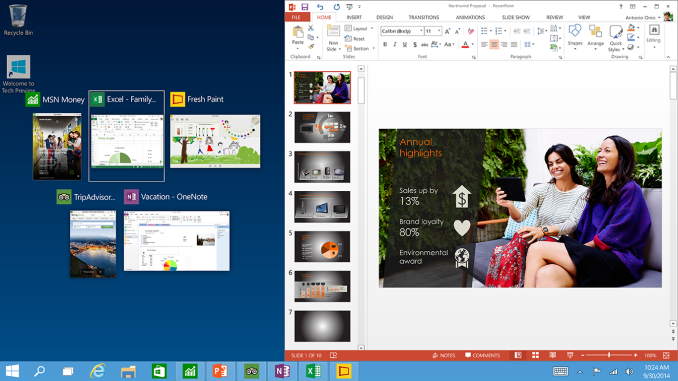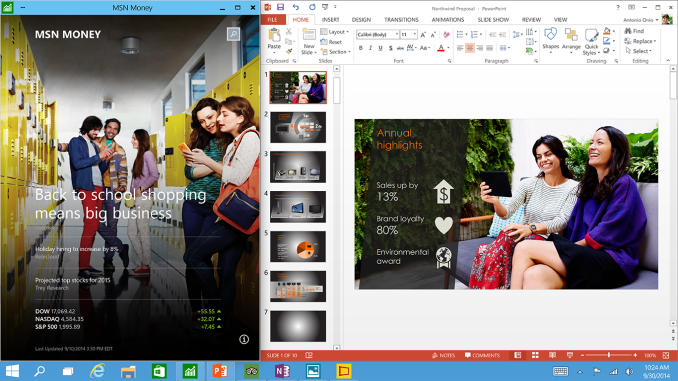Windows 10 Technical Preview First Impressions: The Return Of The Desktop
by Brett Howse on November 13, 2014 8:00 AM EST- Posted in
- Software
- Microsoft
- Windows 10
Closing Thoughts
If Windows 8 was “Touch First” then clearly Windows 10 is not. The current technical preview is very much geared towards the traditional mouse and keyboard user. This will change of course over the next several months, as the touch features get integrated back into Windows 10. As a user of all types of Windows devices, I welcome this change. It allows me to be more productive on my desktop, but still use the touch based Start Screen on a tablet or convertible notebook. Some good things have been done here to hopefully embrace the current user base, as well as new device types.
There are a number of features aimed squarely at businesses. If Microsoft wants to avoid another Windows XP with Windows 7 – where businesses do not migrate until they absolutely have to – then these features are certainly a carrot that may entice them to at least try it out. The Start Menu and other desktop additions will be great for the business users, and I think the IT crowd will be happy with a lot of the new additions around device management, identity management, and information management.
This is a technical preview of course, but still I would be remiss to not mention that it is not without its bugs. I have had a lot of issues with Windows Store apps, with many of them crashing especially when they are not the active window. Possibly there are some changes to the underlying WinRT framework for apps in standby but until we hear more about the framework changes then these problems will likely continue. More of this information should come out around the time of the next BUILD conference, scheduled for April 29th to May 1st 2015. Other issues with WinRT apps currently is that even though they can be used in a window, the absolute height of the window is limited. When Windows 8 was launched, WinRT apps were expecting to be either full screen, or snapped to the side. As such, the apps in a window must maintain a minimum height. Hopefully this can get sorted out in the future.
At first glance, Windows 10 looks like Windows 8 with a Start Menu. It is clearly a lot more than that, but even so, as someone very smart told me, that’s not a bad thing. Windows 8 had a lot going for it, but design decisions were made early on, and with a “my way or no way” attitude that it was difficult to use. It seems that Windows 10 really addresses a lot of this, while at the same time keeping and expanding on a lot of the great features that were in Windows 8 and likely overlooked due to a lot of animosity towards it.
The Windows Store is going to be a big part of this, and if the rumors of desktop apps being integrated into the store is true, then the OOBE for Windows 10 will be amazing. All of your settings and apps will now follow you from device to device, with a single log in. A lot of that is already there with Windows 8, but 10 should finish off the last remaining pieces if this is true. It makes a lot of sense, so unless the licensing terms are awful, this could be a fantastic addition to the store.
The Universal App model is also a big piece of the puzzle, but here there is more work to do. WinRT has a lot of advantages, but the framework needs to be updated at a rapid pace in order to draw developers in. It is somewhat seductive to be able to target desktops, laptops, tablets, phones, and the TV with Xbox One with a single application (with multiple interfaces of course) but until the framework is made powerful enough for more apps than just simple web front ends, it may be difficult to realize this idea. Once again, more info should be available at BUILD in regards to this.
I’ve also had some bugginess with the WinRT apps on Windows 8, which I hope will be fixed with Windows 10. At this point though, the WinRT apps are even buggier so likely there will be more pain before this is all corrected.
Although we have only seen the Technical Preview and a single update to it so far, you can see the potential for Windows 10 and what it will be able to accomplish. It is an ambitious goal to provide a single platform across such a swath of different devices, and one that was held back by the user interface before. With Continuum, it appears that it may be the best of both worlds. Even more exciting is how much more upfront and open Microsoft has been on this entire process, with not just the technical preview but also soliciting and requesting user feedback on the changes. One of the biggest change requests was a simple animation on the Start Menu, and that has already been implemented, so this really is a different world than when Windows 8 was given a sneak peek.
Due to the timing of the latest release that just came out, this article is based on the second build of Windows 10 and I have not had a chance to go over any of the changes in the latest built that arrived on November 12th.
Going forward, as we get more updates to the preview we will do our best to keep you fully informed with that the changes are, and how they will affect you. If you want to kick the tires of Windows 10 and you have not yet, just visit http://preview.windows.com and sign up for the technical preview.












198 Comments
View All Comments
valnar - Monday, November 17, 2014 - link
I don't quite understand the Metro app thing on a desktop. It's a regression in every way. Single app, full screen, doesn't run in the background, etc. Yes, I know Apple does this with iOS but it works for a small device, small screen, and limited memory. On a desktop computer, running an app the way Microsoft designed Metro harkens it back to DOS days. It's called Windows, not Window. Glad they are finally fixing some of that in Windows 10.TinHat - Monday, November 17, 2014 - link
+1Ubercake - Monday, November 17, 2014 - link
Seems like Windows 10 is turning out to be everything Windows 8 was meant to be (ie Unified desktop) while incorporating customer feedback. Looks pretty good.Kutark - Monday, November 17, 2014 - link
Really wish they would at least give the option of enabling aero again. I know in the end its a relatively minor quibble, but i can't express in words how much i hate the stupid pastel themed title bars/windows, etc.Kutark - Monday, November 17, 2014 - link
I should also mention, while win10 looks like a nice step in the right direction, i still think they're going to get the shaft with gamers when steamos comes out (depending on developer support of course). I can honestly say that i've not once, literally not once, had a need or ever clicked, used, or looked at the stupid touch interface (whatever they call it) in months of using windows 8.1. I just need a desktop where i can put icons, a web browser, etc. I don't need "apps" ala a smartphone. If i do, i'll use my smartphone/tablet. Desktops are primarily for "serious business" and all this crap does is get in the way of your ability to efficiently use the system.That being said all the backend stuff in windows 8.1 is great. I will say it works well.
Che - Tuesday, November 18, 2014 - link
I am so in agreement with the above. It is killing me to give up aero. Everytime I see these pics of windows 10, or use windows 8/8.1 it just visually hurts.jrs77 - Tuesday, November 18, 2014 - link
I don't want something fancy for touch-screens and all these widgets, apps, etc.I'm using Windows only on my workstation and for that I need an OS that works with keyboard and mouse first and foremost.
Microsoft should'nt try to integrate all the devices but simply have one OS for mobile devices and one for dektop workstations.
R. Hunt - Tuesday, November 18, 2014 - link
This is still FrankensteinOS, and "Modern" apps look and feel like they were running on a mobile emulator rather than actual desktop applications. Sorry, not impressed, not really seeing how this is any different from Windows 8 or what the hype is all about. All I see is Microsoft still desperately trying to push Metro, their App Store, and associated services on desktop users.Techstedt - Tuesday, November 18, 2014 - link
"a lot"JackMenendez - Wednesday, November 19, 2014 - link
I don't know why it is so hard to understand Windows 8.x failure. There are different kinds of input for navigation and feedback to that input. The design of the UI should be optimum for the kind of input used. If you have a touch screen then a touch screen UI is probably what you are looking for; Windows 8.1 great. If you don't have a touch screen, then a mouse and/or keyboard input UI is what you are looking for; Windows 7 great. When Microsoft put a touch screen UI on a system with only mouse and keyboard input then it is not optimum; it is not what people want. Microsoft went one step further, they took away a UI optimized for mouse and keyboard and replaced it with a UI optimized for touch when most computers don't have touch. This move is called shooting the foot off.Someday, we will have a computer that understands speech so well that we won't need a navigation input. Kind of like the fictional computers on Star Trek. Will we put a touch UI on these? Will it be
"Computer, touch the start button then touch the sensors button, then touch the scan enemy ship button"
Or will it be
"Computer, Scan the enemy ship"?
One kind of UI for all things represents complete ignorance of how people use computers. Stack Exchange lists VIM as one of the most popular IDE's for writing code; for C++ VIM is as popular as Visual Studio. VIM, think about it. For some things touch and mouse are not as good as something developed in the early 1970's but Microsoft does not seem to get that.